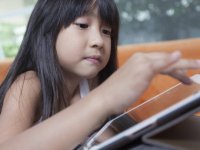Is Your School #FutureReady?
How long did you spend clearing your email inbox of Cyber Monday messages this week? The flood of digital shopping alerts can leave you nostalgic for simpler times -- until you remember the frustration of those good old days, when your home Internet connection was probably too slow for e-commerce. According to the Cyber Monday legend, the workplace, with faster broadband access, became a gateway for online holiday shopping way back in 2005.
By now, more than 70 percent of American homes have broadband access, up from just three percent in 2000, according to the Pew Research Center. Meanwhile, an estimated 40 million American students are still waiting for the expanded access that will let them take full advantage of online content and tools for learning.
Education Superhighway, a nonprofit advocacy group backed by tech entrepreneurs, estimates that 72 percent of America's schools lack sufficient Internet infrastructure for digital learning. Trends such as "bring your own device" have expanded access to digital tools, but haven't necessarily coincided with an increase in bandwidth.
Trying to use Wi-Fi at school can feel like "sucking peanut butter out of a straw," according to Thomas Murray, state and district learning director for the Alliance for Excellent Education. The typical K-12 public school, he notes, has the same Internet access as the average home, but with 200 times more users.
Rural and high-poverty schools are more likely to be on the wrong side of this digital divide. Some 84 percent of teachers worry that technology is contributing to greater disparities between affluent and disadvantaged schools and school districts, according to the Pew Research Center.
Jordan Shapiro expanded on these concerns in a recent post for the Hechinger Report. He writes:
"[Digital literacy] is not only about skills, but also about cognition, etiquette, motivation, socialization, and culture -- the context within which one uses the tools...Because rich kids have better access to digital tools, they are learning to think, behave, and make meaning in ways that will likely correlate with elite status and success in the future. Poor kids are not learning the same things."
The #FutureReady Pledge
Two recent events have the potential to help education get up to speed when it comes to internet access and equity. In November, Federal Communications Commission Chairman Tom Wheeler proposed making an additional $1.5 billion available through the E-Rate program to bring high-speed connections to schools and libraries.
Also last month, President Obama convened 100 of the nation's most-connected superintendents and school leaders at the White House. These educators have been tapped to lead the administration's "Future Ready" efforts to advance digital learning. They started by taking the #FutureReady pledge, which goes well beyond expanding connectivity. The pledge calls on schools to teach students to be engaged, responsible digital citizens; to provide teachers with personalized professional learning opportunities; and to expand access to quality digital content to support student learning.
Fittingly, students also had a voice in this event. Jimmy Casas, a high school principal from Bettendorf, Iowa, who attended the summit, predicts that meeting the #FutureReady challenge will require an expansion in "student-led initiatives that give students a voice in curriculum offerings, school policies, design of classroom and other learning spaces, lesson/unit design, student-led conferences and feedback on teacher effectiveness in the classroom."
In the months ahead, a series of regional #FutureReady summits will bring together more school leaders, students, and other community members to develop strategic plans for using technology to support personalized learning. Find out about events in your area here: Take part in the national conversation by following the hashtag #FutureReady.
What is your school or district doing to make sure students and teachers have the digital access and opportunities they need? Please share your insights in the comments section below.
